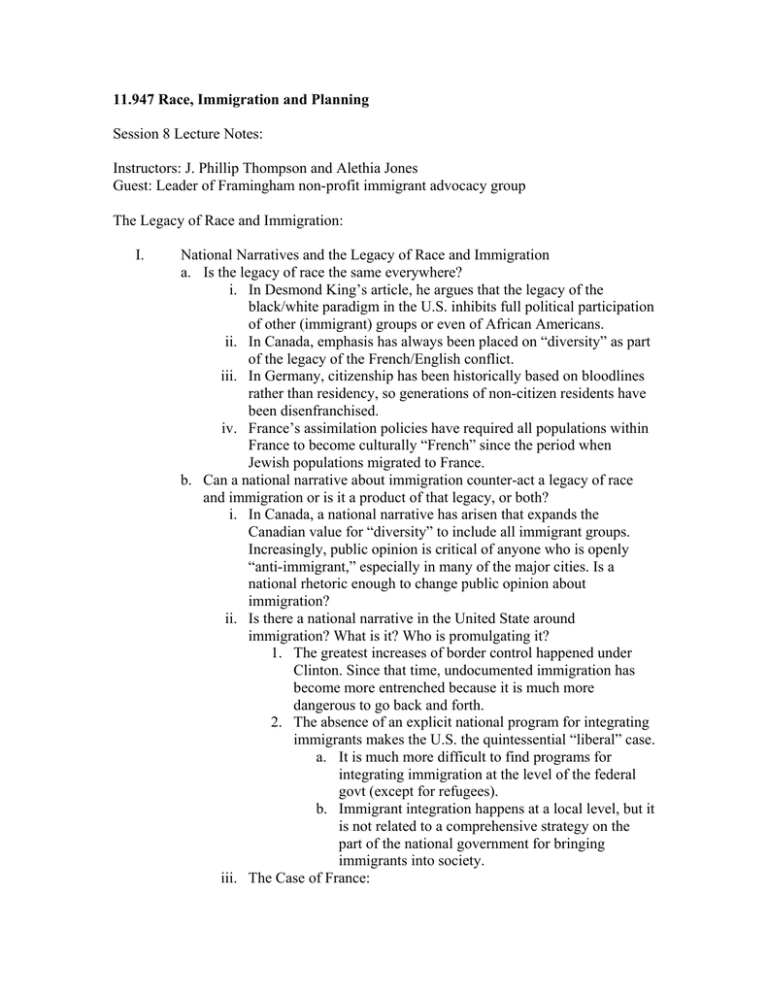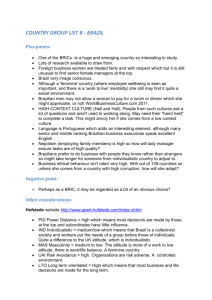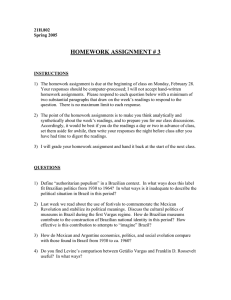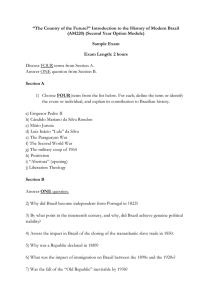11.947 Race, Immigration and Planning Session 8 Lecture Notes:
advertisement

11.947 Race, Immigration and Planning Session 8 Lecture Notes: Instructors: J. Phillip Thompson and Alethia Jones Guest: Leader of Framingham non-profit immigrant advocacy group The Legacy of Race and Immigration: I. National Narratives and the Legacy of Race and Immigration a. Is the legacy of race the same everywhere? i. In Desmond King’s article, he argues that the legacy of the black/white paradigm in the U.S. inhibits full political participation of other (immigrant) groups or even of African Americans. ii. In Canada, emphasis has always been placed on “diversity” as part of the legacy of the French/English conflict. iii. In Germany, citizenship has been historically based on bloodlines rather than residency, so generations of non-citizen residents have been disenfranchised. iv. France’s assimilation policies have required all populations within France to become culturally “French” since the period when Jewish populations migrated to France. b. Can a national narrative about immigration counter-act a legacy of race and immigration or is it a product of that legacy, or both? i. In Canada, a national narrative has arisen that expands the Canadian value for “diversity” to include all immigrant groups. Increasingly, public opinion is critical of anyone who is openly “anti-immigrant,” especially in many of the major cities. Is a national rhetoric enough to change public opinion about immigration? ii. Is there a national narrative in the United State around immigration? What is it? Who is promulgating it? 1. The greatest increases of border control happened under Clinton. Since that time, undocumented immigration has become more entrenched because it is much more dangerous to go back and forth. 2. The absence of an explicit national program for integrating immigrants makes the U.S. the quintessential “liberal” case. a. It is much more difficult to find programs for integrating immigration at the level of the federal govt (except for refugees). b. Immigrant integration happens at a local level, but it is not related to a comprehensive strategy on the part of the national government for bringing immigrants into society. iii. The Case of France: II. 1. The legacy of the Algerian war has resulted in a longstanding policy of assimilation dating back to Jews. The policy is enacted in the military and school system as mechanisms of acculturation. 2. In France, immigrants and minorities are described as “the problem.” Race and Equality: a. What is equality? i. Does it mean everyone is treated equally but expected to conform to a single standard? ii. Or does it mean embracing differences? iii. At the local level it is understood as coming out of conflicts between different groups. b. What is the process of racialization? i. The ability to create a narrative and social structures and institutions to marginalize another group ii. This process can be extended to any number of groups. c. Case: Brazilian workers at Logan Airport i. On March 24th, 14 Brazilian janitorial staff were arrested at Logan Airport for cleaning facilities on the secure side of the airport without proper identification. 1. The immigrants were found to be undocumented and subsequently underwent deportation hearings. 2. Media coverage emphasized the connection between their illegal status and their threat to national security. (See Boston Herald Article: “Logan hasn’t Learned Post-9/11 Lessons; Airport sweep uncovers lax security, nets 14 aliens.”) ii. Why were Brazilian janitors targeted as a threat? 1. One of the largest groups of illegal immigrants in the United States is Canadian, many of whom hold high-level positions in the financial industry. 2. One could argue that all the Canadians that are here illegally could pose a real security threat. So why not target the illegal Canadian financiers? iii. Historical Construction of Threats 1. Historically, the idea of who is threatening has been tied to class and racial categories. 2. These social constructions have a huge impact on how government policies around security are enforced. 3. E.g. The Patriot Act: a. Laws that were passed as part of the Patriot Act are now being applied in certain states toward gangs. b. Many Civil Rights groups opposed the Patriot Act because they foresaw that transition to use against “domestic terrorists.” III. 4. The way immigrants look, where they come from, both factor into how these issues get defined: Who “belongs” and who doesn’t? Where do people live? What jobs do they have? Immigration in Framingham: a. Major problem: Brazilians don’t fit into any of the existing racial/ethnic categories or silos. Latinos claim to help Brazilians but don’t do anything for them. For other minorities it is the same thing. Client Personal Background: b. Reasons for emigrating from Brazil: i. Came from a small community where opportunities were determined by political connections ii. Educational opportunities were limited and sub-par. Only two options for university were available in the area: 1. Law school 2. Dental school iii. Professional opportunities were teaching, law, or dentistry; but even with the training, few job opportunities existed through which to practice. iv. Local education was not good enough to qualify residents for the better jobs in larger companies. v. Many immigrants who leave their home-country leave because the opportunities available in the country are not available to them. c. Early experiences of America: i. When I came to the U.S., there were not many Brazilians. I originally lived in Boston, but moved to Framingham because I learned that a Brazilian woman there needed health care, and I had some training in heath work. ii. Once in Framingham, I started building connections, and as more immigrants arrived, I helped people find jobs. d. Building a Community: i. Public Education 1. Educating Framingham residents about Brazil was necessary because they had few reference points by which to understand Brazil and its immigrant population. ii. Business Development: 1. Brazilian business in Framingham began with a money transfer office to help Brazilians send money back to their families. (The government now requires all transfers to go through a bank, and as a result, immigrants are paying a really high price to wire money.) 2. Once that office opened, demand for Brazilian products emerged. 3. Now about 225 small businesses in the Brazilian community. 4. Non-profit gives assistance to plan and open businesses. a. A major problem for the Brazilian community is that 80% of its businesses do not operate on business plans; people often go broke. iii. Churches and Social Organizations 1. Framingham already had a Catholic Church for its Portuguese community that Brazilians could attend 2. Initially, Brazilians were poorly received by the church because they did not understand the concept of tithes. 3. I convinced some missionaries to help reach out to the community to teach them about tithes, and afterward, they enjoyed a much warmer reception from the Church, which subsequently grew. 4. Churches are important, but it is also important to have a neutral organization where people who are not connected to the church can go if they are having a problem. Churches are not as concerned with government issues and the nonprofit filled that void. 5. A number of social clubs and nightclubs have opened to serve the Brazilian community as well. e. Facing a Backlash: i. Framingham is a town of about 65,000 people. Italians, African Americans, Jewish, Asian, Indian, Latino, Brazilian all live there; it is extremely diverse. Because Brazilians came and opened so many businesses, however, they have become a very visible community. ii. Two years ago, a group formed with the intention of eliminating Brazilians in the community. iii. This group has been video-taping Brazilians and their businesses and has been trying to expose any undocumented immigrants in order to undermine the credibility of this non-profit. It has even started a television show with the intention of turning public opinion against Brazilians. 1. The group is targeting this non-profit because it is a foundation of information sharing and support for the Brazilian community. 2. Many Brazilians are scared by this anti-immigrant activity because even those who are citizens often have family members who are not yet. iv. Because the Brazilian community is silent, no one knows that he is wrong. 1. The negative publicity is infiltrating the opinion of people outside of the Brazilian community. v. In response, the non-profit has documented all of the group’s activities and threats, and a Brazilian group has formed to meet with the Attorney General. 1. Brazilians are not the ones who are committing crimes but instead are victims but they are afraid to complain. 2. Brazilian women are victimized especially based on media images of Brazilian women as overtly sexual, etc. vi. Despite losing $30,000 through poor event-planning, the non-profit has recovered and is continuing to provide services to the community. Current Non-Profit Activities: f. New Framingham Planning Effort: i. Through a Reader’s Digest Grant, three communities (Springfield, North Adams, and Framingham) were selected to participate in a Star Partnership revitalization effort. ii. As part of this plan, $100 Million is being invested in the revitalization of the downtown: 1. Renovation of storefronts 2. Construction of 300 apartment units a. 1 bdrm units at $1200/mo b. 2 bdrm units at $1750/mo c. Affordable units will be added if Federal money comes in. iii. Most of the businesses and residents in the area are currently Brazilian, but this will change as part of the renovation. 1. How can the non-profit ensure that the Brazilian community benefits from this investment and planning effort? 2. How can the non-profit mitigate any negative effects on Brazilian business owners? a. Have tried to help business owners plan for the changes. b. Many do not believe the changes will affect them or do not even have time to think about it. c. Some Brazilians have taken advantage of Accion’s consultation and small loans. 3. At this point, most of the approvals are in place, the community cannot greatly impact the content of the plan. g. Other Activities: i. Created 5 Committees: 1. Business 2. Youth and Family Education 3. Culture 4. Health 5. Citizenship ii. Each is working to reach out to the Brazilian community and educate them about how to thrive and be protected. 1. Health: a. The health committee is working with people who work with cleaning products. b. 11% of accidents at work happening are with Brazilians. c. Cleaning products that had gone off the market because they were unsafe are now back because Brazilians will buy them without knowing exactly what they are using. 2. Youth and Family Education: a. Works with parents to help them manage their children’s education. b. Many of the parents and children cannot go to college because of their immigration status c. Many Brazilian youth are dropping out of school. d. Parents and educators face a major cultural divide. i. Children use Portuguese at school to avoid dealing with their teachers and English at home to avoid their parents. ii. They are becoming increasingly disconnected. 3. Business: a. Immigrants own many businesses b. Most want to be able to become legal if the opportunity arises, so they all stay current on their taxes. c. Information on Tax-ID numbers spreads mostly through word-of-mouth. h. Organizational Capacity i. Leadership: 1. We really need a leadership program. 2. People want to lead, but they are not good at sharing tasks and delegating 3. When people try to do things alone, they cannot succeed and exciting initiatives end up dying. ii. Consulate 1. Information is the biggest challenge for immigrants 2. The Brazilian consulate in Boston is the only consulate in all of New England. 3. Large numbers of immigrants come with incomplete information 4. It becomes a confrontational rather than supportive environment. iii. Media 1. The only Brazilian TV Channel is the biggest channel in Brazil, and it does not see itself as responsible to the needs of local, immigrant audiences. IV. 2. There is a Brazilian radio station. 3. Brazilian newspapers are not well written, but they are improving. iv. Organizations 1. Only 2 Brazilian organizations exist in the U.S.: this nonprofit and the Immigrant Center in Boston. Other groups are now emerging in other areas and trying to follow our model. 2. Because so few organizations exist, the people working to help the community tend to burn out. 3. Some Latino groups claim Brazilians, but their work does not really target Brazilian populations. i. Brazilian Racial/Ethnic Identity: i. Brazilians are not really Latino (not Spanish-speaking), but they do not fit into any of the other categories either. On the census, even the “Other” category does not quite fit. 1. This makes it difficult to track the community’s growth and progress in terms of socio-economic indicators. 2. It is also difficult to find resources that support work in Brazilian communities. 3. It can be more difficult to communicate information to a population that is poorly defined. a. Lack of information often leads to victimization, especially for immigrants. Business in Brazil: a. Lacemaking i. Indigenous women living in a very poor section of Brazil were involved in making lace for $3/month. ii. I wanted to start a business with them selling the lace in the United States for more money. iii. The community did not have enough food or water, so we helped them organize to buy food wholesale; we helped finance the purchase of eyeglasses for the women who had lost their eyesight. iv. Eventually, we helped the women start a seed bank and planted near the water to help them retain more of their water. v. Will eventually start a vegetable garden to give the community access to fruit and vegetables.





